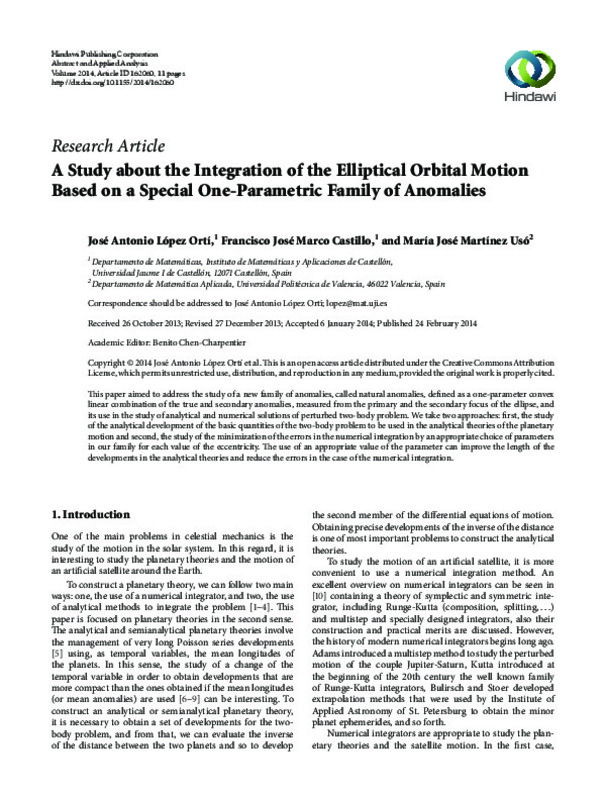JavaScript is disabled for your browser. Some features of this site may not work without it.
Buscar en RiuNet
Listar
Mi cuenta
Estadísticas
Ayuda RiuNet
Admin. UPV
A Study about the integration of the elliptical orbital motion based on a special one-parametric family of anomalies
Mostrar el registro sencillo del ítem
Ficheros en el ítem
| dc.contributor.author | Lopez Orti, Jose Antonio
|
es_ES |
| dc.contributor.author | Marco Castillo, Francisco José
|
es_ES |
| dc.contributor.author | Martínez Uso, María José
|
es_ES |
| dc.date.accessioned | 2015-06-04T07:16:46Z | |
| dc.date.available | 2015-06-04T07:16:46Z | |
| dc.date.issued | 2014 | |
| dc.identifier.issn | 1085-3375 | |
| dc.identifier.uri | http://hdl.handle.net/10251/51223 | |
| dc.description.abstract | This paper aimed to address the study of a new family of anomalies, called natural anomalies, defined as a one-parameter convex linear combination of the true and secondary anomalies, measured from the primary and the secondary focus of the ellipse, and its use in the study of analytical and numerical solutions of perturbed two-body problem. We take two approaches: first, the study of the analytical development of the basic quantities of the two-body problem to be used in the analytical theories of the planetary motion and second, the study of the minimization of the errors in the numerical integration by an appropriate choice of parameters in our family for each value of the eccentricity. The use of an appropriate value of the parameter can improve the length of the developments in the analytical theories and reduce the errors in the case of the numerical integration. | es_ES |
| dc.description.sponsorship | This research has been partially supported by Grant P1.1B2012-47 from University Jaume I of Castellon. | en_EN |
| dc.language | Inglés | es_ES |
| dc.publisher | Hindawi Publishing Corporation | es_ES |
| dc.relation.ispartof | Abstract and Applied Analysis | es_ES |
| dc.rights | Reconocimiento (by) | es_ES |
| dc.subject | Formula | es_ES |
| dc.subject.classification | MATEMATICA APLICADA | es_ES |
| dc.title | A Study about the integration of the elliptical orbital motion based on a special one-parametric family of anomalies | es_ES |
| dc.type | Artículo | es_ES |
| dc.identifier.doi | 10.1155/2014/162060 | |
| dc.relation.projectID | info:eu-repo/grantAgreement/UJI//P1·1B2012-47/ | es_ES |
| dc.rights.accessRights | Abierto | es_ES |
| dc.contributor.affiliation | Universitat Politècnica de València. Departamento de Matemática Aplicada - Departament de Matemàtica Aplicada | es_ES |
| dc.description.bibliographicCitation | Lopez Orti, JA.; Marco Castillo, FJ.; Martínez Uso, MJ. (2014). A Study about the integration of the elliptical orbital motion based on a special one-parametric family of anomalies. Abstract and Applied Analysis. 2014:1-11. https://doi.org/10.1155/2014/162060 | es_ES |
| dc.description.accrualMethod | S | es_ES |
| dc.relation.publisherversion | http://dx.doi.org/10.1155/2014/162060 | es_ES |
| dc.description.upvformatpinicio | 1 | es_ES |
| dc.description.upvformatpfin | 11 | es_ES |
| dc.type.version | info:eu-repo/semantics/publishedVersion | es_ES |
| dc.description.volume | 2014 | es_ES |
| dc.relation.senia | 269278 | |
| dc.identifier.eissn | 1687-0409 | |
| dc.contributor.funder | Universitat Jaume I | es_ES |
| dc.description.references | Simon, J.-L., Francou, G., Fienga, A., & Manche, H. (2013). New analytical planetary theories VSOP2013 and TOP2013. Astronomy & Astrophysics, 557, A49. doi:10.1051/0004-6361/201321843 | es_ES |
| dc.description.references | Brumberg, V. A. (1995). Analytical Techniques of Celestial Mechanics. doi:10.1007/978-3-642-79454-4 | es_ES |
| dc.description.references | Nacozy, P. E. (1969). Hansen’s Method of Partial Anomalies: an Application. The Astronomical Journal, 74, 544. doi:10.1086/110833 | es_ES |
| dc.description.references | Brumberg, E., & Fukushima, T. (1994). Expansions of elliptic motion based on elliptic function theory. Celestial Mechanics & Dynamical Astronomy, 60(1), 69-89. doi:10.1007/bf00693093 | es_ES |
| dc.description.references | López, J. A., & Barreda, M. (2007). A formulation to obtain semi-analytical planetary theories using true anomalies as temporal variables. Journal of Computational and Applied Mathematics, 204(1), 77-83. doi:10.1016/j.cam.2006.04.029 | es_ES |
| dc.description.references | López Ortí, J. A., Martínez Usó, M. J., & Marco Castillo, F. J. (2008). Semi-analytical integration algorithms based on the use of several kinds of anomalies as temporal variable. Planetary and Space Science, 56(14), 1862-1868. doi:10.1016/j.pss.2008.02.035 | es_ES |
| dc.description.references | Sundman, K. F. (1913). Mémoire sur le problème des trois corps. Acta Mathematica, 36(0), 105-179. doi:10.1007/bf02422379 | es_ES |
| dc.description.references | Nacozy, P. (1977). The intermediate anomaly. Celestial Mechanics, 16(3), 309-313. doi:10.1007/bf01232657 | es_ES |
| dc.description.references | Janin, G. (1974). Accurate computation of highly eccentric satellite orbits. Celestial Mechanics, 10(4), 451-467. doi:10.1007/bf01229121 | es_ES |
| dc.description.references | Velez, C. E., & Hilinski, S. (1978). Time transformations and Cowell’s method. Celestial Mechanics, 17(1), 83-99. doi:10.1007/bf01261054 | es_ES |
| dc.description.references | Ferr�ndiz, J. M., Ferrer, S., & Sein-Echaluce, M. L. (1987). Generalized elliptic anomalies. Celestial Mechanics, 40(3-4), 315-328. doi:10.1007/bf01235849 | es_ES |
| dc.description.references | Brumberg, E. V. (1992). Length of arc as independent argument for highly eccentric orbits. Celestial Mechanics and Dynamical Astronomy, 53(4), 323-328. doi:10.1007/bf00051814 | es_ES |
| dc.description.references | López Ortí, J. A., Gómez, V. A., & Rochera, M. B. (2012). A note on the use of the generalized Sundman transformations as temporal variables in celestial mechanics. International Journal of Computer Mathematics, 89(3), 433-442. doi:10.1080/00207160.2011.611502 | es_ES |
| dc.description.references | Deprit, A. (1979). Note on Lagrange’s inversion formula. Celestial Mechanics, 20(4), 325-327. doi:10.1007/bf01230401 | es_ES |
| dc.description.references | Chapront, J., Bretagnon, P., & Mehl, M. (1975). Un formulaire pour le calcul des perturbations d’ordres �lev�s dans les probl�mes plan�taires. Celestial Mechanics, 11(3), 379-399. doi:10.1007/bf01228813 | es_ES |








